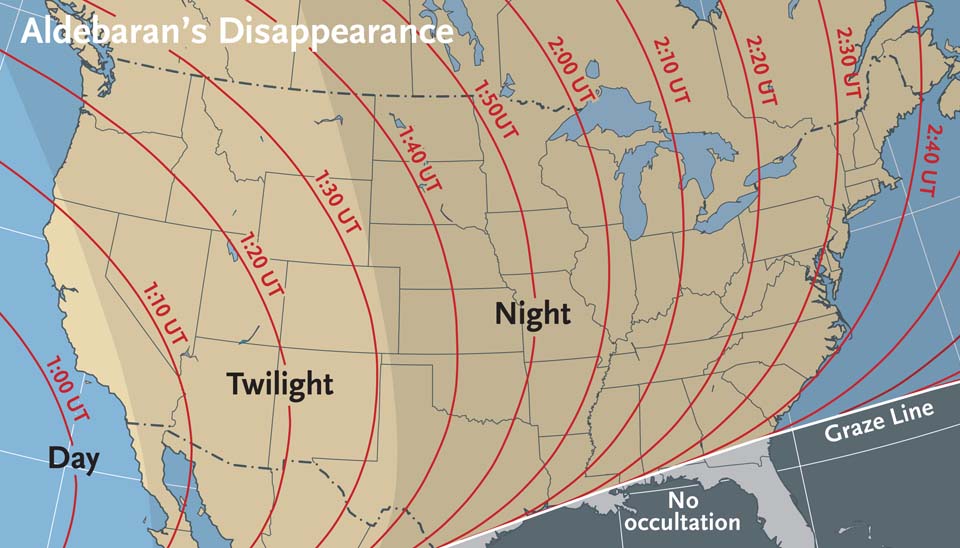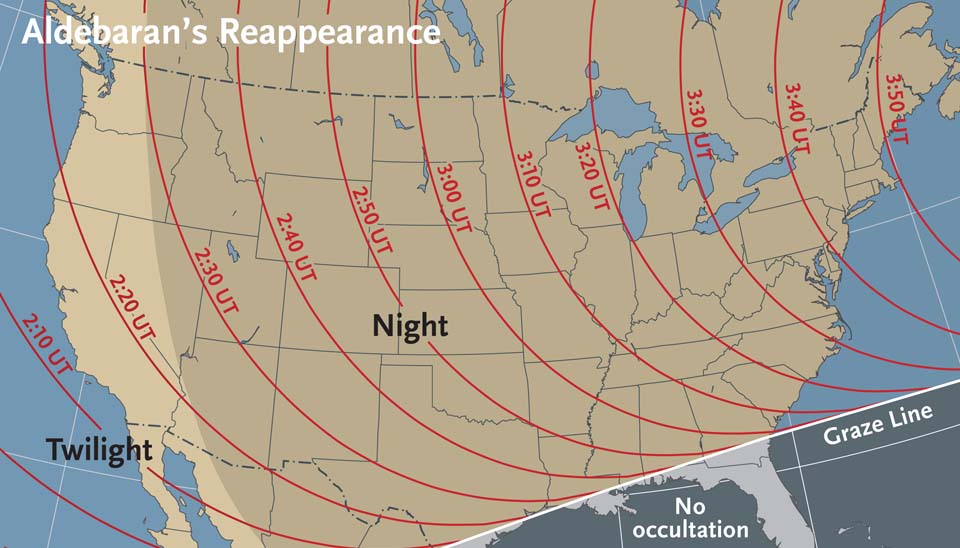North Americans have front-row seats when the Moon covers up the brightest star in Taurus.
On the evening of January 19th, observers all across North America can witness the Moon covering, and then uncovering, the 1st-magnitude star Aldebaran (Alpha Tauri). It happens in the evening. High in the sky. On the Moon's dark limb rather than the bright limb. For almost all of the U.S. and Canada. What's not to like?
This is another in a series of 49 monthly Aldebaran crossings that will continue through September 2018. But most of them don't happen for wherever you are, and nearly half of those that do occur in daylight (though don't let that stop you; Aldebaran is bright enough to glimmer through a clear blue sky in a telescope, as occurred last October 2nd).
The Moon on the evening of the 19th will be waxing gibbous. A waxing Moon leads with its dark edge as it moves along its orbit against the starry background. So Aldebaran will disappear on a dark background away from the dazzling glare of the sunlit lunar surface.

S&T: Tony Flanders
With the Moon 82% illuminated, its night portion will probably be too weakly Earthlit to show in a scope. So you'll have to keep a steady watch as Aldebaran's time draws near to catch it the moment it vanishes. Its reappearance on the bright limb will be less obvious, but still easy to see if you're watching.
You can estimate when the star will disappear and reappear for your location using Sky &Telescope's Aldebaran occultation charts, shown at right (click on each for a larger view).
Or you can refer to these detailed timetables for many locations. (Note that this link provides three separate tables: for the disappearance, the reappearance, and the locations of cities).

S&T: Tony Flanders
The occultation's southern limit — the graze line where the star skims the Moon's southern limb — runs from south Georgia near the Gulf Coast and across South Texas. Along this line you might see the star wink out and back more than once as it skims behind lunar hills and valleys along the southern limb.
Aldebaran has a large apparent disk as stars go, 21 milliarcseconds wide. That's as big as a pea seen from just 15 miles (25 km) away. So you might see Aldebaran fading and reappearing not quite instantaneously if the Moon's edge skims it at a low angle from your location. A grazing occultation is the only way an amateur can "resolve" the face of a star other than the Sun. A nearby orange or red giant like Aldebaran offers your best chance.
 4
4
Comments
Anthony Barreiro
January 19, 2016 at 3:23 pm
What's not to like? Thick clouds and rain! Darn. California needs the rain, but why couldn't it rain tomorrow?
You must be logged in to post a comment.
[email protected]
January 21, 2016 at 10:26 pm
we live in Chicago and it was so hazy you couldn't even see Aldebaran!! I wish was clear.
You must be logged in to post a comment.
Frank-ReedNavigation.com
January 19, 2016 at 4:47 pm
An occultation also provides an interesting, exotic case of "celestial navigation". If you observe Aldebaran disappear at a particular moment, then you know you are on a roughly elliptical curve on the Earth's surface. Some details here: http://fer3.com/arc/m2.aspx/Aldebaran-occ-g34263.
This sort of navigation --measuring the angle between the Moon's limb and a bright star (in this case, that angle is zero) at a known instant of time-- was the basis for the sextant navigation originally planned for the Apollo missions to the Moon. Each Apollo command module had a computer-driven sextant built right into the hull. With the exception of Jim Lovell on Apollo 8, the Apollo astronauts treated this technique as an un-necessary backup to the primary inertial navigation and ground tracking. But today navigation enthusiasts and anyone with an interest in positional astronomy can try out "Apollo navigation" right here on terra firma by observing this occultation of Aldebaran.
Frank Reed
http://ReedNavigation.com/aboutfer/
You must be logged in to post a comment.
Kevin-Fetter
January 20, 2016 at 11:23 am
https://www.dropbox.com/s/ispr5d8a7wjds9v/Aldebaran.wmv?dl=0&preview=Aldebaran.wmv
You must be logged in to post a comment.
You must be logged in to post a comment.